April 11, 2025
How many times has something like this happened to you? That sleek coffee maker in the ad promises barista-level lattes. But before hitting Add to Cart, you hesitate. A quick scroll through brand websites, customer reviews, and creator demos helps build the trust you need at that moment to make a decision.
The Bazaarvoice Shopper Preference Report 2025 reveals that 47% of consumers trust customer testimonials and peer reviews when shopping on social media. More so, for 39%, confidence in a purchase grows with the sheer volume of reviews, proving that authenticity isn’t a tagline but a necessity.
It’s the trust that is reshaping how we shop in the era of economic uncertainty. Let’s take a deep dive to see how trust defines the buyer’s journey and how brands can keep up.
How customer reviews and brand research drive shopping decisions
What should I buy, and where do I look for answers and reviews?
These are the questions every shopper asks before they begin. We surveyed over 8,000 consumers globally, and the results are here: brand websites remain the go-to source before buying a product, with 41% of shoppers choosing them as their first stop.
Shoppers are looking for product information along with credibility. They want the complete picture, from detailed specifications to authentic descriptions and real customer experiences, all in one location.
However, shoppers don’t stop at one source. Data shows that many consumers cross-check consumer reviews, expert reviews on social media platforms, and creator reviews before making a purchase.
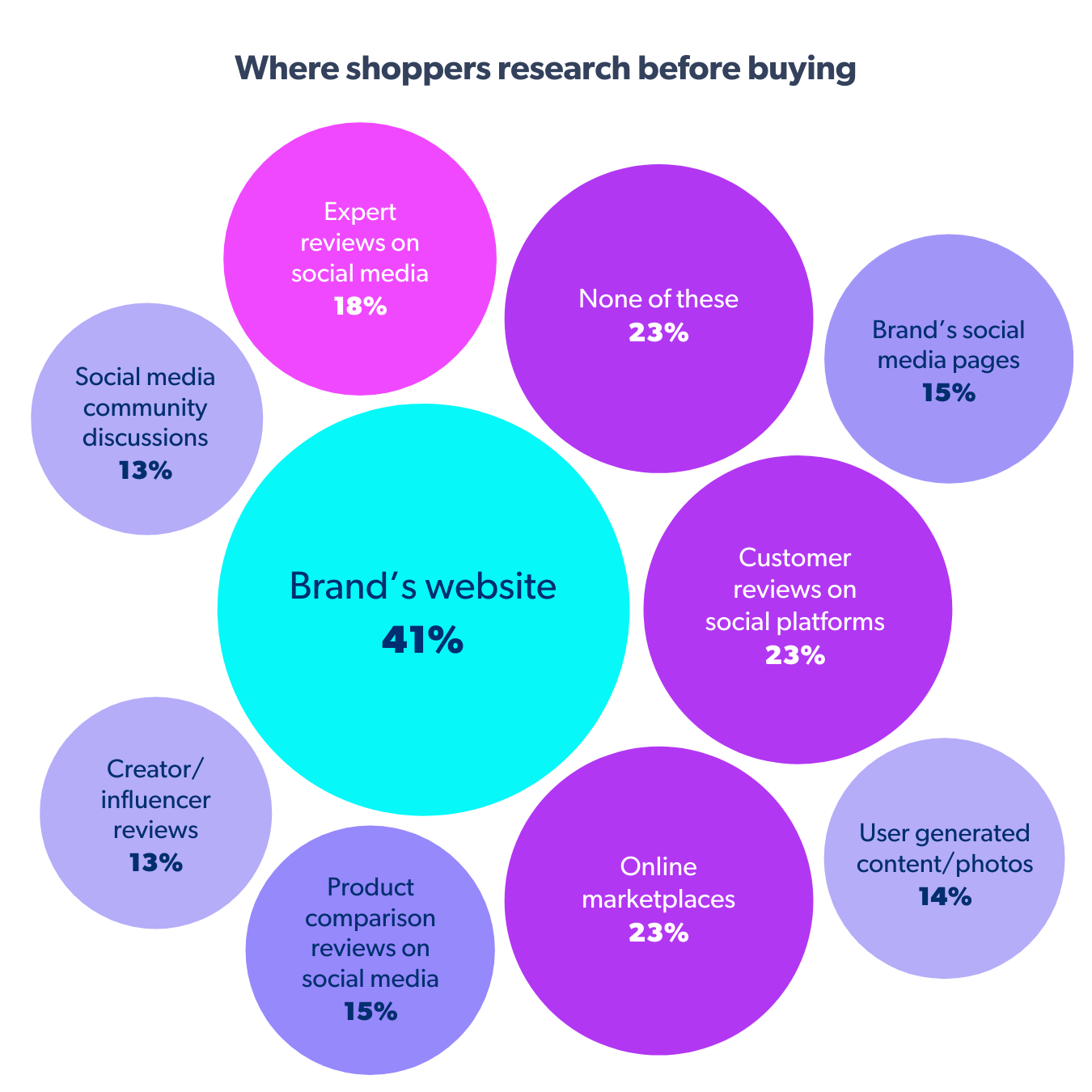
The approach highlights a critical shift in behavior — shoppers rely on brand research for credibility. They also turn to customer reviews and organic reviews on social platforms for real-world experiences.
While brand websites lead overall, shopping behavior varies by product category. Brand websites are the top choice, particularly for electronics and apparel. For marketplace-heavy categories like grocery and DIY/ home/hardware, shoppers prioritize organic and expert reviews on social platforms and online marketplaces.
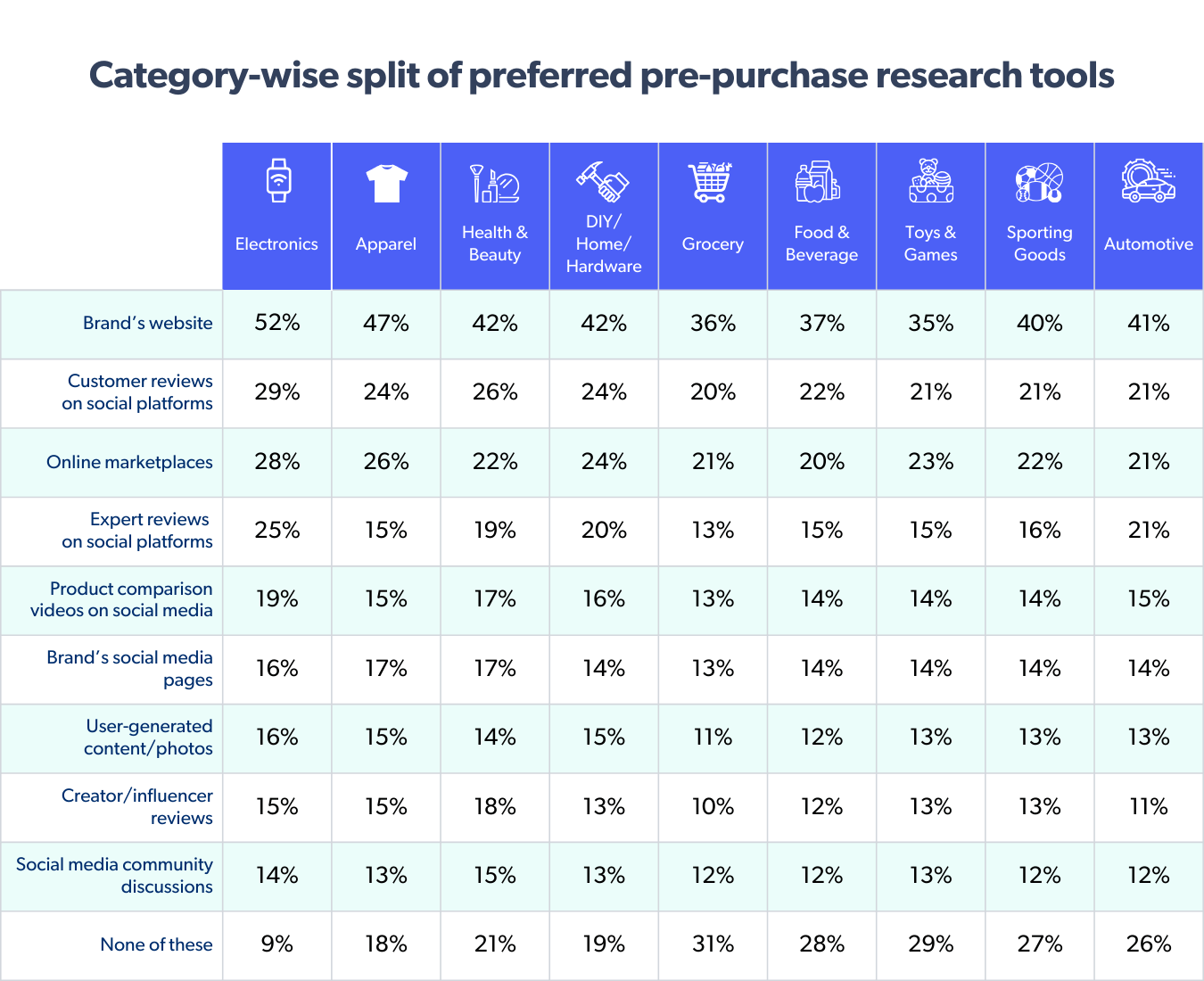
How consumer testimonials shape trust
Shoppers navigate multiple sources when researching products — but which voices truly influence their final decisions? While brand websites provide the foundation, shoppers seek reliable information sources, such as customer testimonials that build confidence in their choices.
The data tells a compelling story: peer experiences outweigh brand-led content. Nearly half (47%) of social shoppers rely primarily on organic sources — customer reviews and product ratings (26%), along with peer recommendations (21%). Branded content, on the other hand, includes professional product reviews, a brand’s official posts, and social media ads, which account for 37%. This indicates that shoppers prioritize real experiences over promotional content.
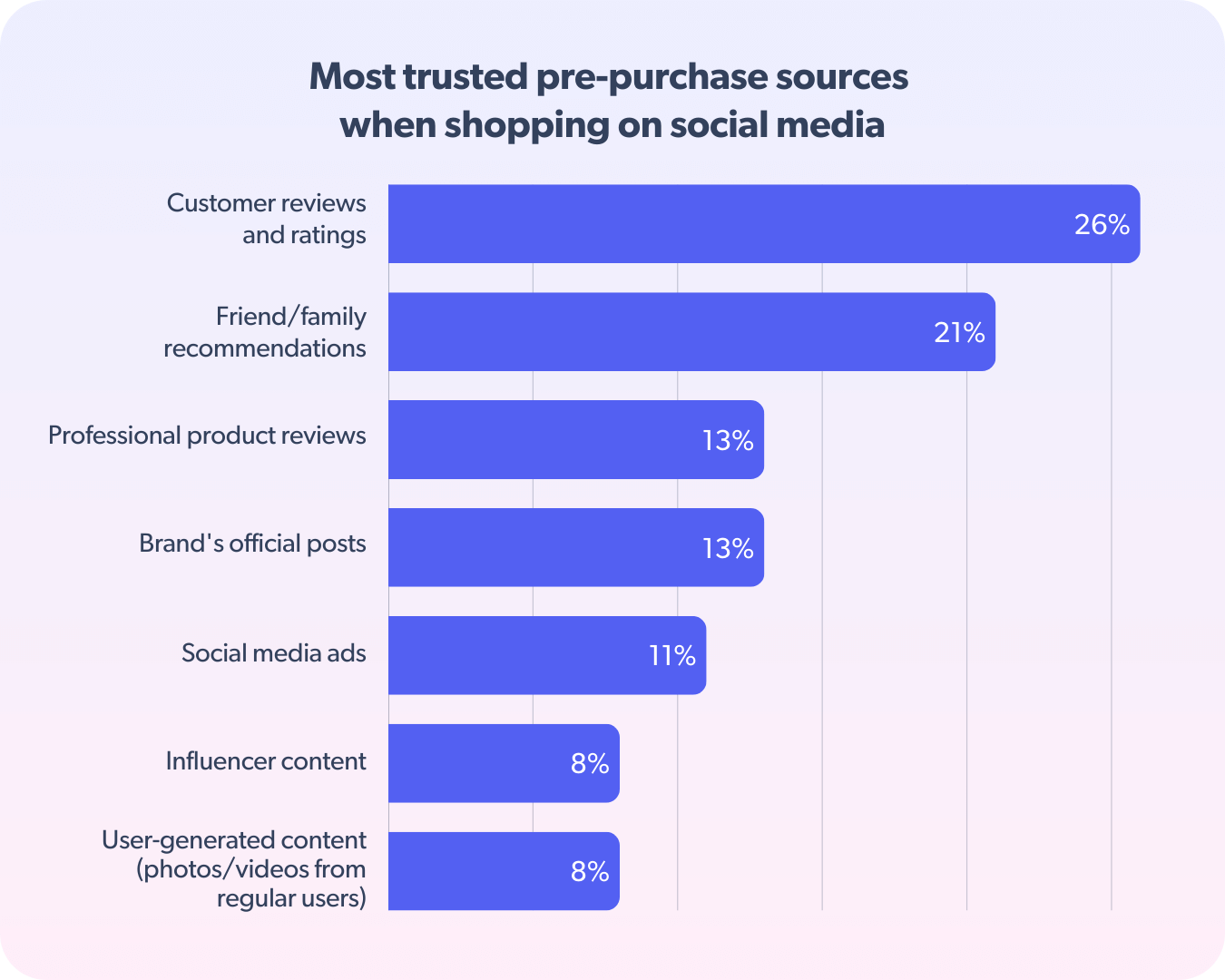
Peer recommendations vs. product ratings: What influences each age group
Trust also follows generational lines, creating distinct patterns of influence.
Younger consumers (18-34) heavily rely on visual content like photos, videos, and UGC in their buying journey. One in four younger shoppers still considers ads and creator content alongside customer reviews, suggesting that social influence still plays a role — but only when backed by authentic consumer feedback.
For older shoppers (55+), the trust equation shifts. They place the highest trust in customer reviews and ratings while largely dismissing social media ads and influencer content.
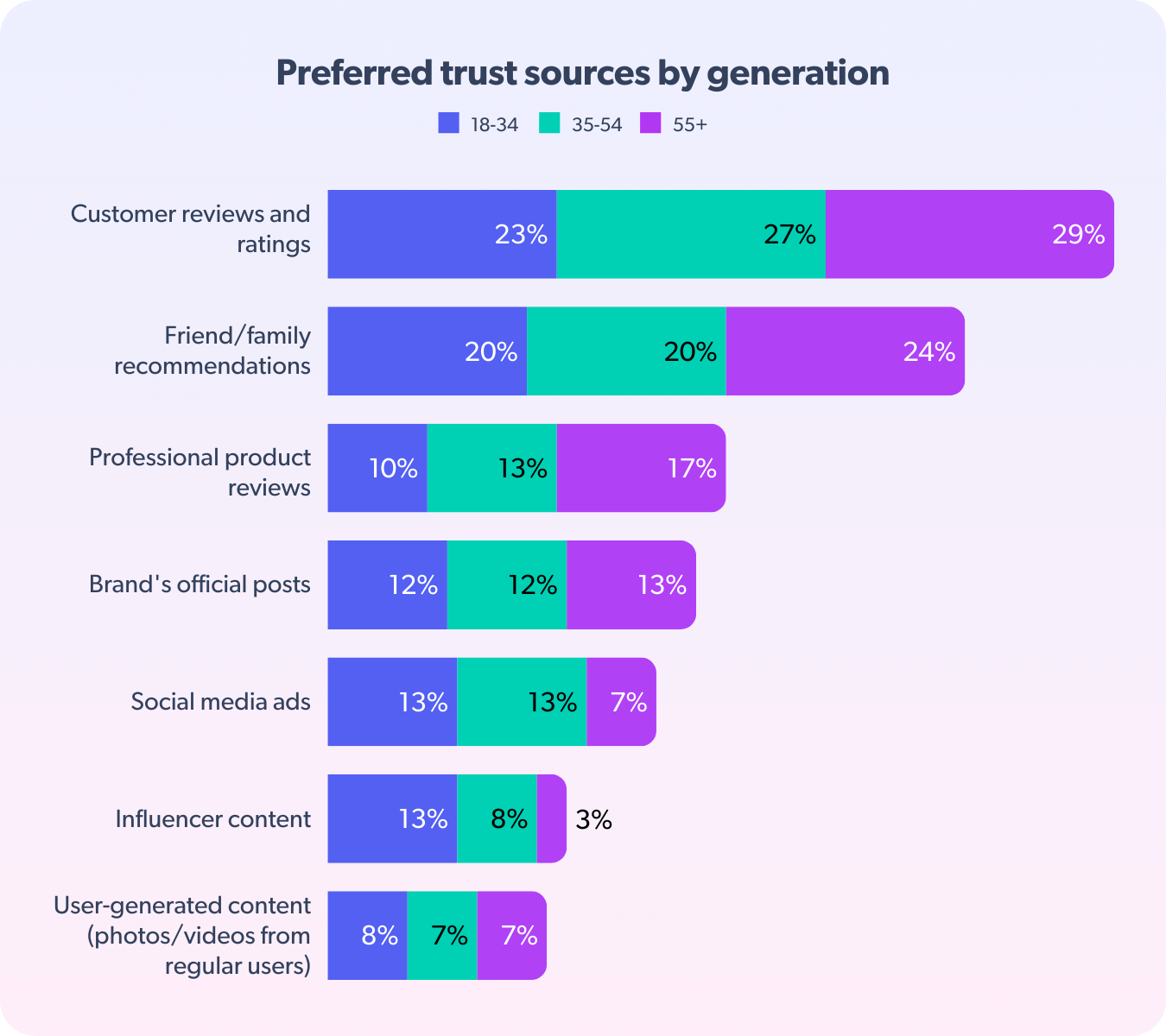
Brands must tailor trust-building strategies based on the demography. Gen Z and millennials engage with interactive UGC, product demos, and creator-led content, while Boomers and Gen X shoppers expect detailed customer testimonials and professional product reviews.
Why review volume matters
Trust isn’t built in a single moment — it’s an ongoing journey.
As shoppers navigate an overwhelming array of options, they look for clear indicators that a product is widely tested, reviewed, and validated by others.
Across global markets, review volume is one of the strongest trust signals, with 39% of shoppers saying that the number of customer reviews significantly impacts their confidence in a product.
A single review — good or bad — isn’t enough to sway today’s shoppers. They want multiple reviews. At least 44% of Gen Z and millennials prioritize a high number of customer reviews and consider it a critical trust factor. For boomers and silent generation shoppers, 36% say a high volume of customer reviews makes them more likely to trust a product.
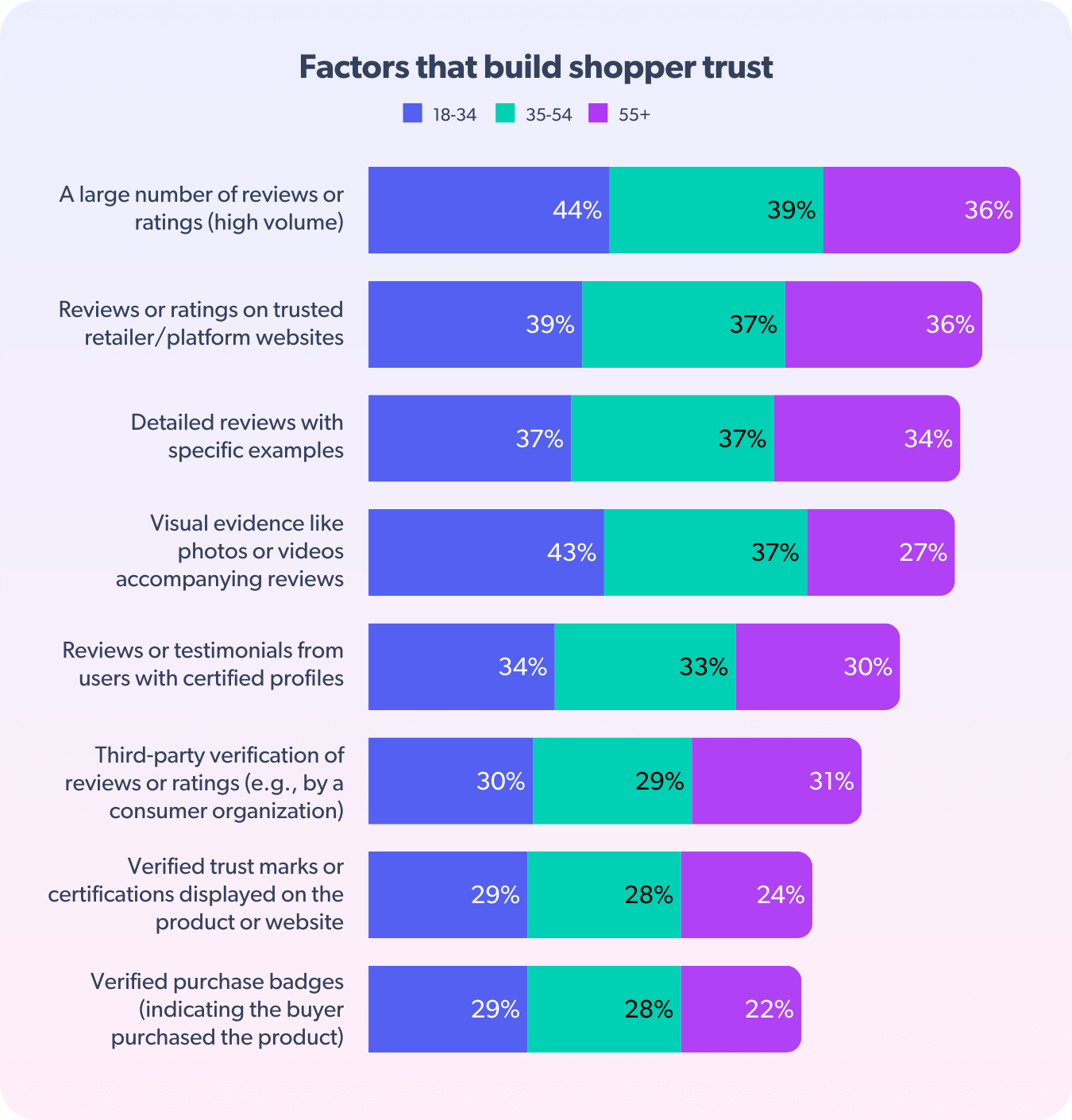
This highlights how shoppers seek validation through both quantity and quality. A higher volume of consumer reviews signals credibility, while detailed testimonials and visual proof reassure that a product meets expectations.
Consumers scrutinize negative reviews before making a purchase.
Brands often fear negative reviews — but they shouldn’t. Shoppers don’t stop at the first bad review they see. Instead, they dig deeper. Our survey found that nearly half keep researching until they feel confident, while 39% look for different reviewers to compare opinions. More than one-third visit the website directly for additional research, and 23% actively search for additional negative customer reviews.

This multi-step process emphasizes how shoppers don’t just react to a negative review. Their journey takes them across brand websites, third-party platforms, and social discussions, which reinforces the need for brands to maintain credibility across all touchpoints.
For brands, this presents a clear opportunity to be present across all touchpoints with authentic product ratings and consumer testimonials.
Building trust in social commerce
As we’ve seen, shoppers rely heavily on verification across multiple sources. This trust-seeking behavior peaks in social commerce, where the line between entertainment and shopping continues to blur.
Social shoppers, especially younger generations, don’t just want product promotions. They want authentic, experience-driven storytelling. Gen Z and millennials are leading the charge, with 56% of 18-34-year-olds purchasing a product based on a creator’s recommendation.
Not all product categories perform equally on social platforms. While social commerce spans various industries, some categories consistently see stronger engagement and conversion rates than others.
Apparel tops the list, with 46% of shoppers making fashion-related purchases through social media. The health and beauty sector follows closely (43%).
Even traditionally offline categories like DIY/home hardware (21%) and sporting goods (17%) are finding their place in social commerce, powered by creators showcasing real-world product applications.
Social commerce isn’t simply about convenience — it’s about trust-driven discovery where consumers find products through genuine human connections. For brands, leveraging authentic consumer testimonials, detailed product ratings, and visible customer reviews can enhance credibility and turn hesitant shoppers into confident buyers.
How shoppers verify the authenticity of creator content
As creator-led shopping experiences grow in influence, how do shoppers decide which creators they trust?
Shoppers don’t take recommendations at face value but look at multiple trust signals before purchasing. For 43% of shoppers, the most important indicator of authenticity is a creator acknowledging a product’s pros and cons.
Other critical factors include unscripted, natural content, as shoppers quickly disengage from content that feels overly rehearsed or sales-driven. Transparency about sponsorships, personal storytelling, and genuine audience interaction build credibility.
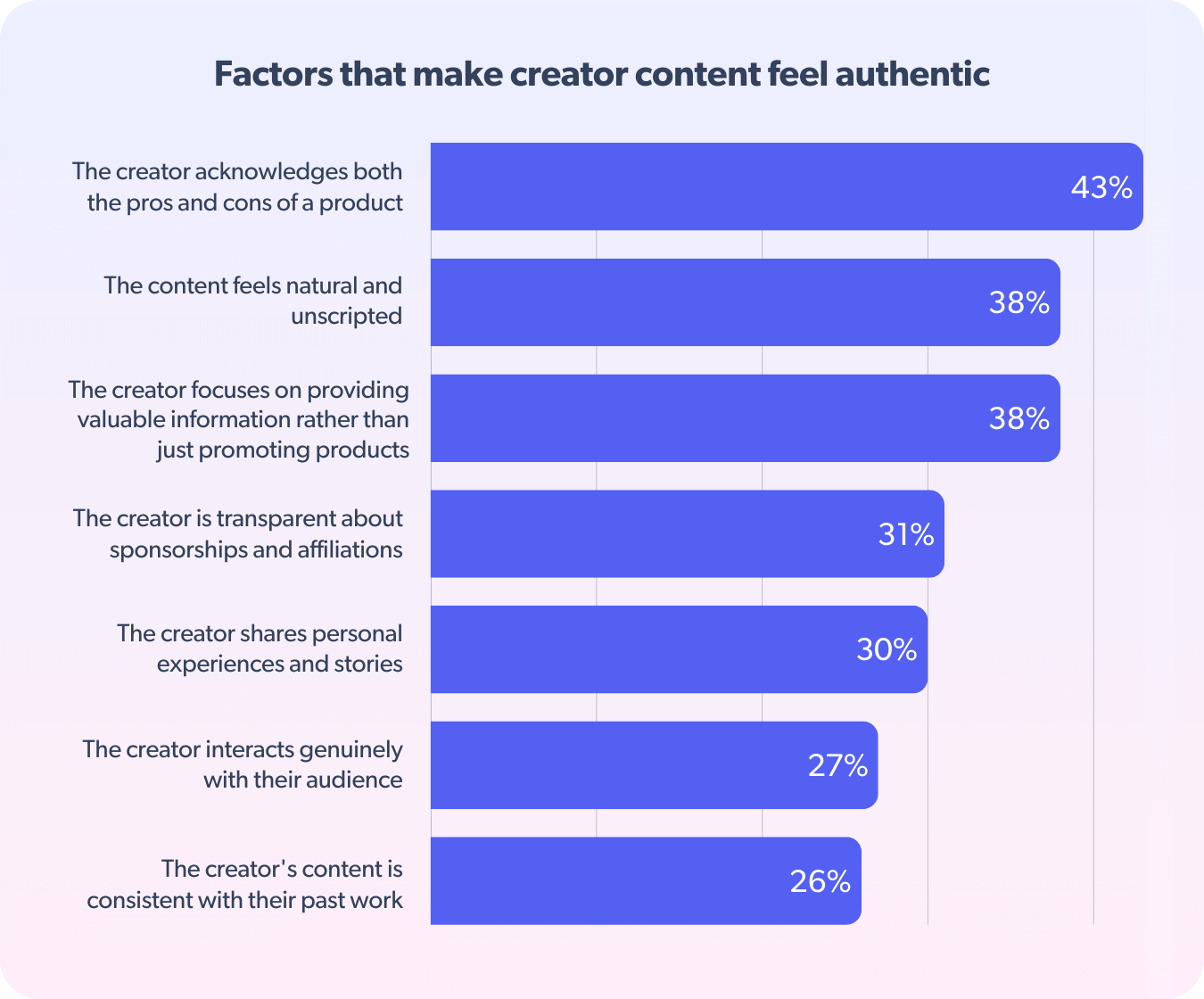
Even after watching a creator’s recommendation, the verification journey continues. Half of shoppers (50%) check customer reviews elsewhere before buying, and 47% return to the brand’s website for further brand research and to verify details. This crucial finding circles back to our earlier insight: brand websites remain the cornerstone of consumer trust, serving as the verification hub in an increasingly complex shopping journey.
So, what concrete steps can brands take to capitalize on these insights and win in this new landscape of trust-based commerce? The answer lies in strategically connecting these touchpoints to create a seamless trust journey.
The bottom line: Trust is built, not bought
Throughout this journey, we’ve seen how shoppers navigate the complex path to purchase. The story is clear: shoppers don’t just look for products — they look for proof. They rarely rely on a single peer recommendation or source before buying. Instead, they move across brand websites, customer reviews, social media, and creator content, seeking validation at every step.
Here’s what we’ve learned about trust-building from this year’s report:
- Shoppers place authenticity above advertising, transparency over polished messaging, and real experiences over traditional marketing.
- Brand research remains essential. Brand websites serve as the backbone of pre-purchase research, providing in-depth product information, clear product ratings, and authentic consumer testimonials.
- Customer reviews act as powerful trust signals that guide shoppers toward confident decisions. The volume, depth, and transparency of these reviews matter just as much as their overall rating.
- Social commerce continues to grow, but shoppers remain cautious. Organic reviews and UGC further reinforce trust. Shoppers want real-world perspectives before committing.
- Negative customer reviews don’t necessarily stop purchases—unclear or inauthentic responses do. Shoppers use critical feedback as a research tool, diving deeper into multiple sources before deciding.
Looking ahead: What brands can do to win
- Amplify customer reviews: Make UGC highly visible — on product pages, search results, and social media. Customer testimonials in ads and incentives for leaving reviews strengthen credibility.
- Embrace transparency: Brands that acknowledge and respond to all customer reviews—not just positive ones earn long-term trust.
- Rethink advertising: Think trust first. UGC-driven campaigns, long-term creator partnerships, and verified consumer testimonials outperform traditional brand messaging.
- Leverage video reviews: Short-form video reviews like unboxings, testimonials, and product demos can boost confidence and conversions.
- Connect review data with personalization: Customer feedback reveals more than sentiment. AI-powered analysis can refine product descriptions and improve messaging and personalized recommendations.
Shoppers are telling us what they prefer—and it’s up to brands to listen.
Get the full picture of evolving shopper behavior in the Bazaarvoice Shopper Preference Report 2025.



